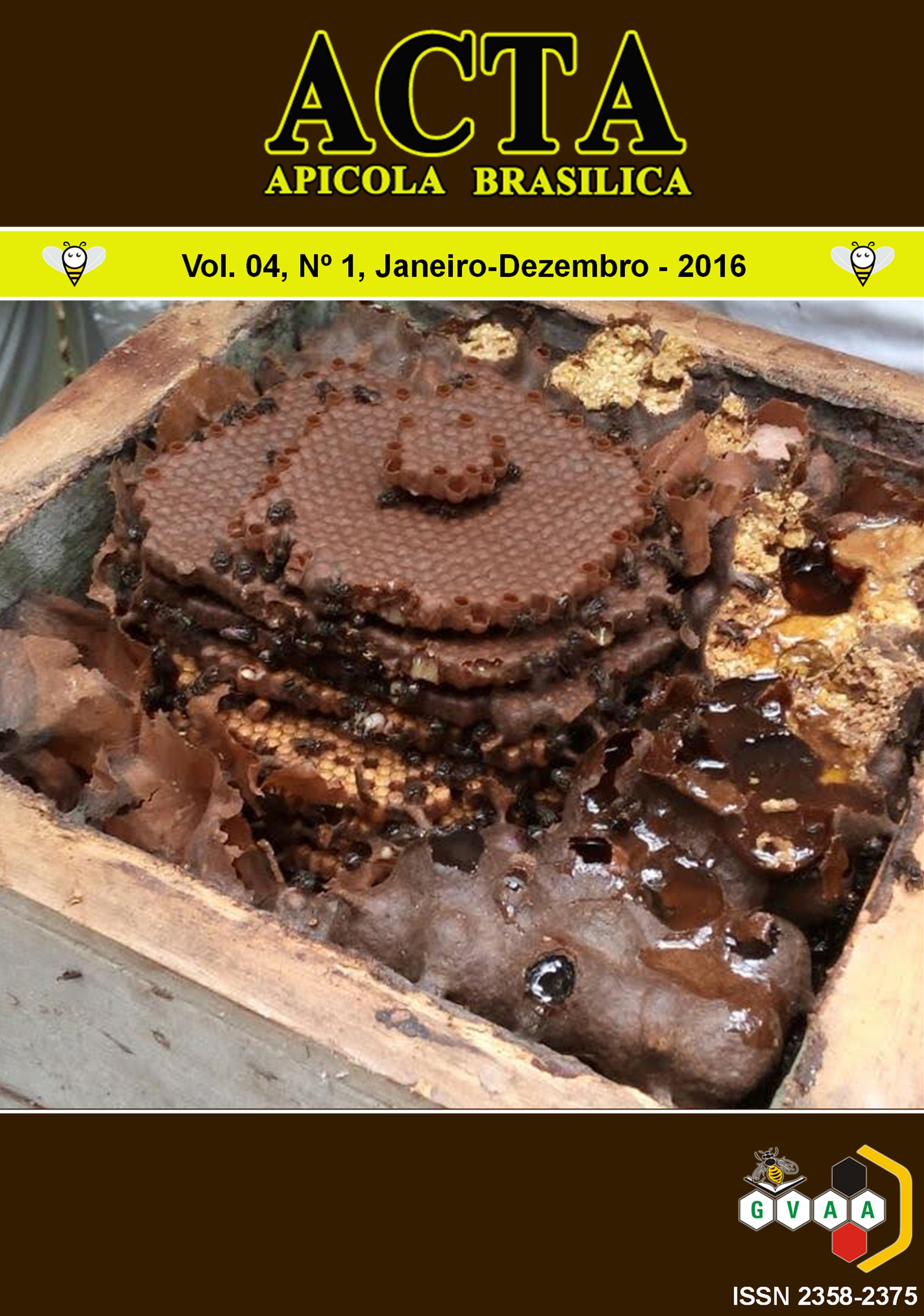Design and Characterization of honey-mint and honey-eucalyptus gumy
DOI:
https://doi.org/10.18378/aab.v4i1.4771Keywords:
Honey, Gumy, Essence mint-eucalyptusAbstract
The derivatives market of the hive and its sub products have had a recent boom in marketing, with products of cosmetology, pharmacology and food observed in apiculture exhibition that exist in different areas the México. This paper describes the design of the formulation of jelly gum with honey, addition with essences of mint and eucalyptus with sensory variation by artificial flavor. Sensorial, physicochemical and microbiological analysis of the product obtained are determined, the level of sensory pleasure be established through comparison with the existing market. It is necessary to standardize the ingredients for the product obtained had the same characteristic sensorial, predominating taste of honey-mint and honey-eucalyptus enriched with strawberry essence, so stipulated by not habitual consumer of honey products through sensory evaluation. Jelly gum obtained with strawberry essence, physicochemical has adequate moisture for storage, is slightly acidic and a range of 58-62 Brix. It was obtained jelly gum with honey-mint and honey-eucalyptus, have a color red, flavor a honey and soft rubbery texture, with good sensory acceptance. Physicochemical and microbiologically the jelly gum with honey-eucalyptus-strawberry and honey-mint-strawberry comply with the official’s standard, also ingestion no risk to health.
Downloads
References
AIDOO, R. P.; DEPYPERE, F.; AFOAKWA, E. O.; DEWETTINCK, K.. Industrial manufacture of sugar-free chocolates? applicability of alternative sweeteners and carbohydrate polymers as raw materials in product development.. Trends in Food Science & Technology. 32(2), 84-96, 2013.
ARCEO P. R.; ABARCA S. V. M. Panorama actual de la apicultura 2016. Consejo Mexicano para el desarrollo sustentable. Comité sistema producto apícola. org. mx. 2014. Consultadoen; http://www.cmdrs.gob.mx/sesiones/Documents/2014/4a_sesion/6_Apicola.pdf
AVILES-SACOTO S.; COOK W. D.; IMANIRAD, R.; ZHU J. Two-stage network DEA: When intermediate measures can be treated as outputs from the second stage. Journal of the Operational Research Society, Vol. 66, Issue 11 1868-1877. 106. 2015.
CABELLOS S. P.; GARCÍA R. M.; RODRÍGUEZ G. F.; GARCÍA J. A. Manual de aplicación del sistema APPCC en industrias de confitería-pastelería, bollería y repostería de Castilla-la Mancha. Segunda Edición. Ed. Lagomar artes Gráficas. 2000.
CARREÓN E. M. G.; NAVARRO C. A. R. Elaboración de golosinas tipo gomita bajas en azúcar y adicionadas con extractos de verduras. Tesis profesional de licenciatura. Facultad de Ciencias Químicas, BUAP. 2014.
CDT. Azúcar, confitería y chocolatería. Plan Nacional de Desarrollo. Estudios y Publicaciones. 2014. Consultado en; https://colaboracion.dnp.gov.co/CDT/Desarrollo%20Empresarial/Azucar.pdf
CERIMELE, E.; REYNALDI, F. J; HENNING, C.; ALBO, G. N; RINGUELET, J. Dosis Letal Media (DL50) de algunos aceites esenciales y biocidas efectivos para el control de Ascosphaera apis en Apis mellifera L.. REDVET. Revista Electrónica de Veterinaria, Octubre, 1-12. 2010.
CODEX ALIMENTARIUS. Norma del Codex para la Miel CODEX STAN 12 suplemento 2. 1990.
D’AMELIA, R. P.; DUERST, M. D. Celebrando la Química. El lado dulce de la química; el caramelo. American Chemical Society ACS in spanish. 2014.
EBADI M. Desk Reference of Clinical Pharmacology. Tree Edition. CRC Press Taylor y Francis Group. 2010.
FAOSTAT. Organización de las Naciones Unidas para la Agricultura y la Alimentación. Base de datos estadísticos con relación a la alimentación y agricultura Oct, 2015. Consultado en: http://faostat.fao.org/site/535/default.aspx.
FUSADES. Innovación Tecnológica en confitería y chocolatería. PROINOVA-Innovación tecnológica. 2014. Fondo multilateral de Inversiones. Banco de Interamericano de Desarrollo (BID).
GONZÁLEZ N. S. A.; TAMAYO C. J. A.; TOLEDO L. V. M.; TAMAYO C., E. N.; VARGAS V. M. L. Productos con alto contenido de miel, como opción para incrementar su uso en Yucatán. Revista Mexicana de Agronegocios, vol. XVII, núm. 33, julio-diciembre, pp. 576-586. 2013.
IMANIRAD R.; AVILES-SACOTO S.; COOK W. D.; ZHU J. Partial input to output impacts in DEA: The case of DMU-specific impacts. European Journal of Operational Research, Vol. 244, Issue 3 837-844. 2015.
INSTITUTO NACIONAL DE GEOGRAFÍA E INFORMÁTICA (INEGI). El sector alimentario de México. Ed. Fondo de la Nación. 2014.
LABAU E. El libro de la elaboración de bombones. Desde el más sencillo hasta el más espectacular. 2015. Ed. Praido
LIGIA, B. DE A; M.; KLAUS, M.; STRAMM, A. H.; ORTRUD M.; BARTH A. DE S. F; LETICIA M. E. Comparative study of the physicochemical and palynological characteristics of honey from Melipona subtinida and Apis mellifera. Food Science & Technology. 48(1698-1706). 2013.
NORMA OFICIAL MEXICANA. NOM-145-SCFI-2001. Información comercial-etiquetado de miel en sus diferentes presentaciones. Secretaria de Economía. Ed. Fondo de la Nación.
ORTIZ, R. S. La domesticación de las plantas medicinales en Cuba: importancia y experiencias concretas. Biocenosis, 16(1-2), 2016.
ORTUÑO S.F. Manual Práctico de esencias esenciales aromas y perfumes. 2010. Ed. Aiyana.
PEREDO-LUNA H.A.; PALOU-GARCIA E.; LÓPEZ-MALO A.; Aceites esenciales métodos de extracción. 2009. Temas selectos de Ingeniería de alimentos. 3-1(24-32).
RODRÍGUEZ S. V. E. Las gomas: excelencia en funcionalidad. Industria Alimentaria. (4): 43,45. 2006.
SAGARPA. Programa Nacional Pecuario 2007-2012.Secretaria de agricultura, Ganadería, desarrollo rural, Pesca y Alimentación. 2012. Ed. Fondo de la Nación.
SUAREZ R. E. B. Evaluación de la actividad antibacteriana de los aceites esenciales de Zacate de limón (Cymbopogon Citratus CD. Stapf), Eucalipto (Eucalyptus ssp.) y clavo de olor (Sysygium aromaticum L), Sólos y en combinación, contra pseudomonas aeruginosa ATCC 27853. (2012). Septiembre 2011 a Junio 2012 (Doctoral dissertation, Universidad Nacional Autónoma de Nicaragua, UNAN-MANAGUA).
UNAM. Atlas de las Plantas de Medicina Tradicional Mexicana Eucalipto, Eucalyptus globulus Labill, Myrtaceae. Monografía. 2010. Consultadoen: http://www.medicinatradicionalmexicana.unam.mx/monografia.php?l=3&t=eucalipto&id=7828
UNAM. Atlas de las Plantas de Medicina Tradicional Mexicana. Yerbabuena, Mentha citrata Ehrb, Labiatae. Monografía. 2010. Consultadoen: http://www.medicinatradicionalmexicana.unam.mx/monografia.php?l=3&t=&id=7675
VV.AA.; N.; GOBEL V. Caramelos, toffee y chocolates: Dulces de elaboración casera. 2014. Ed. Fackelträger.
ZAMBRANO D. J. G.; DEL VALLE S. H. S. Extracción de aceites esenciales de plantas autóctonas menta (Mentha piperita L.), palo santo (Bursera graveolens), hierba luisa (Cimbopongon citratus) de la provincia de manabi, con potenciales de industrializacion. (2015). (Doctoral dissertation, Ing. Ulbio Alcivar Cedeño.MC. SC.).
ZARRATEA, A.; HARBERLE, A. Informe internacional de la miel, Quinquenio2009-2013. 2014. Instituto de Fomento Empresarial, corrientes exporta. Boletín Diciembre. www.corrienteexporta.gov.ar.













